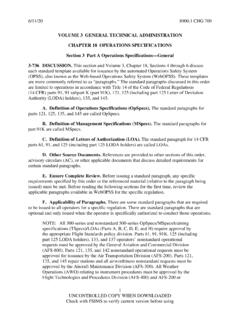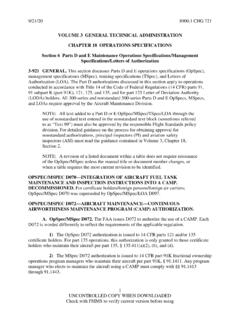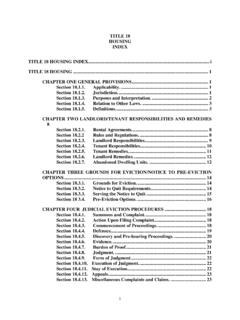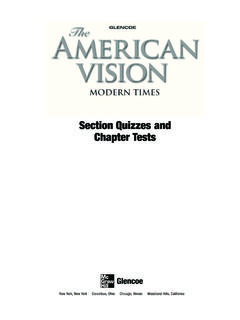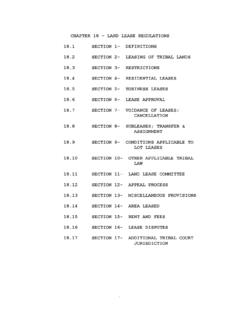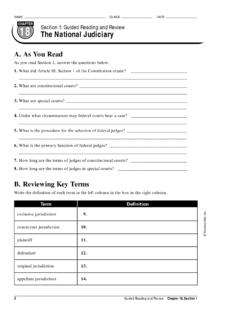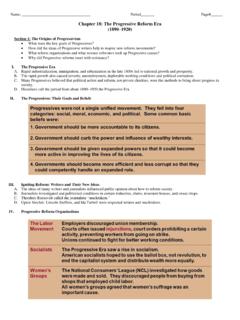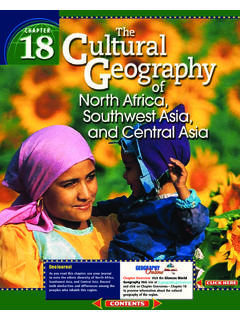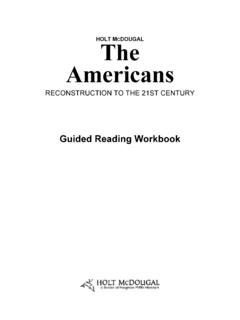Transcription of 1288704 IRNSG AK BW.qxd 19.01.2006 13.27 Page 2 ...
1 interactive reading andNotetaking study GuideANSWER KEYFor use with both on-level and adapted Page Page 51 Thursday, January 19, 2006 1:23 PMInteractive reading and notetaking study Guide ANSWER KEYU pper Saddle River, New JerseyBoston, Massachusettsfor use with both on-level and adapted Page iii Thursday, January 19, 2006 1:21 PMCopyright by Pearson Education, Inc., publishing as Pearson Prentice Hall, Boston, Massachusetts 02116. Allrights reserved. Printed in the United States of America. This publication is protected by copyright, and permissionshould be obtained from the publisher prior to any prohibited reproduction, storage in a retrieval system, or trans-mission in any form or by any means, electronic, mechanical, photocopying, recording, or likewise.
2 For informationregarding permission(s), write to: Rights and Permissions Department. Pearson Prentice Hall is a trademark of Pearson Education, is a registered trademark of Pearson Hall is a registered trademark of Pearson Education, 0-13-129870-41 2 3 4 5 6 7 8 9 1009 08 07 06 05 ContentsChapter 1 .. 1 Chapter 2 .. 2 Chapter 3 .. 4 Chapter 4 .. 6 Unit 1 Pulling It Together .. 8 Chapter 5 .. 8 Chapter 6 .. 9 Chapter 7 .. 12 Citizenship Handbook .. 13 Unit 2 Pulling It Together .. 14 Chapter 8 .. 14 Chapter 9 .. 16 Chapter 10.. 17 Unit 3 Pulling It Together .. 19 Chapter 11.. 19 Chapter 12.
3 21 Chapter 13.. 22 Unit 4 Pulling It Together .. 24 Chapter 14.. 24 Chapter 15.. 25 Chapter 16.. 27 Unit 5 Pulling It Together .. 28 Chapter 17 .. 28 Chapter 18 .. 30 Chapter 19 .. 32 Unit 6 Pulling It Together.. 33 Chapter 20 .. 33 Chapter 21 .. 34 Chapter 22 .. 36 Unit 7 Pulling It Together.. 37 Chapter 23 .. 38 Chapter 24 .. 39 Chapter 25 .. 41 Unit 8 Pulling It Together.. 42 Chapter 26 .. 43 Chapter 27 .. 45 Chapter 28 .. 46 Chapter 29 .. 48 Unit 9 Pulling It Together.. Page iv Thursday, January 19, 2006 1:21 PM Answer(s) specific to On-Level Version. Answer(s) specific to Adapted Key1 OLA Pearson Education, Inc.
4 , publishing as Pearson Prentice Hall. All Rights KeyAnswers are provided for all questions and tasks. Please note that there may be more than one correct answer for specific entries in the notetaking organizers. Students should receive credit for accurate alternate 1 Section 1 Checkpoint the Bering Strait Vocabulary Builder They built temples for and made human sacrifices to their gods. reading Strategy Students should underline the sentence: After defeating half of Mexico during the 1400s, the Aztecs made people pay high taxes. Students should circle the sentence: People turned against them.
5 Checkpoint the Mayas, the Aztecs, and the IncasCheck Your Progress 1. Farming allowed people to settle in one place and led to the development of cities. 2. The Mayas built elaborate temples. The Aztecs built the sacred city of Tenochtitl n. The Incas built a network of study Guide The Land Bridge: ocean levels were lower because of glaciers; Bering Strait; Siberia and Alaska; between 20,000 and 30,000 years ago; people from Asia crossed it into North America; How Early Civilizations Developed: 1. hunters, North America, South America; 2. larger animals, hunting, gathering; 3. 8,000, Mexico, squash, lima beans; 4.
6 Irrigation, water, animals; 5. population, extra, traded; 6. cities; Three Great Civilizations: Mayas: Mexico, Central America; built cities with plazas lined with pyramids, temples, ball courts, and palaces, developed arts, system of government, written language, calendar; Aztecs: Mexico; built Tenochtitl n perhaps largest city in the world at one time, had temples, stone roadways, and floating gardens, conquered half of Mexico; Incas: South America; built great network of roads, buildings of huge stones, produced fine weavings and metalwork, rulers wore gold and silver jewelryChapter 1 Section 2 Checkpoint Mississippians or Mound Builders, Anasazi, HohokamCheckpoint sticks, bones, and shells reading Strategy Students should underline dry ; Students should circle stored water for the dry season Vocabulary Builder Comprised means was made up of or included.
7 The Iroquois included five nations, each with different clans or Far North, Northwest, Far West, Southwest, Great Plains, Eastern Woodlands, Southeast Check Your Progress 1. Culture groups had to adapt their way of life to the environment. 2. They believed spirits dwelled in study Guide First Cultures of North America: Mound Builders: Appalachian Mountains to the Mississippi Valley; constructed mounds for burials and buildings, built the first cities in North America; Anasazi: Southern Utah, Colorado, northern Arizona, New Mexico; built cliff dwellings, made baskets, pottery, and jewelry; Hohokam: deserts of Arizona; skilled at farming, dug canals for irrigation, traded for seashells; Native Americans of North America: Far North Arctic: (environment) harsh, often ice-covered; (way of life) fished, hunted marine mammals.
8 Far North Subarctic (environment) dense forests, climate too cold for farming; (way of life) gathered forest plants, hunted caribou, moose, bear; Northwest: (environment) southern Alaska to northern California; (way of life) hunted and gathered in forests rich with animals and plants, fished in rivers; Far West: (environment) north: cold winters in the forests and grasslands, south: desertlike, warm summers and mild winters; (way of life) people ate small game, fish, and berries; pit houses and cone-shaped houses covered with bark in the south, houses of wooden planks in the north; Southwest: (environment) Arizona, New Mexico, and the southern parts of Utah and Colorado, dry most of the year, summer thunderstorms; (way of life) farming, some hunting, collect and store rain for the dry times, large apartment houses made of adobe; Great Plains: (environment) Mississippi River and the Rocky Mountains; eastern Plains allowed farming, western Plains were too dry and matted with grass to be farmed; (way of life) Eastern Plains: women planted corn, beans, squash, homes were earth lodges.
9 Western Plains: homes were tepees or round pits, buffalo provided food, shelter, clothing, tools; Eastern Woodlands: (environment) southern Canada, Great Lakes, New York, Atlantic coast to Virginia, covered with forests; (way of life) hunting and gathering, farming by 1000; Southeast: (environment) steamy and hot; (way of life) houses on wooden frames with straw mats plastered with mud clay, farmingChapter 1 Section 3 Checkpoint IslamVocabulary Builder possible answers: wealthy, prosperous, richCheckpoint East Africa: Zimbabwe, Kilwa; West Africa: Ghana, Mali, Timbuktu, Songhai reading Strategy Possible answers include: Question: What are some of the elements of modern Page 1 Thursday, December 15, 2005 5:37 PM2 Answer Key Answer(s) specific to On-Level Version.
10 Answer(s) specific to Adapted Pearson Education, Inc., publishing as Pearson Prentice Hall. All Rights that existed in Ancient China? Answer: highways, canals, and a postal systemCheckpoint the magnetic compassCheck Your Progress 1. Possible answers: the Mediterranean Sea, the Red Sea, the Indian Ocean; 2. The Silk Road was a 5,000-mile series of routes that stretched from Xian in China to study Guide The Muslim Link in Trade: Asia, Africa, Europe; Arabian; Islam, Muhammad; conquest; medicine, astronomy; sails; The African Link in Trade: East Africa: Zimbabwe; Kilwa, pottery, ivory; Indian Ocean; West Africa: Middle East, camel caravans; Ghana; gold, salt; Timbuktu; Songhai; The East Asian Link in Trade: China; magnetic compass; Zheng He, 50; Silk Road, road, a series of routes.


